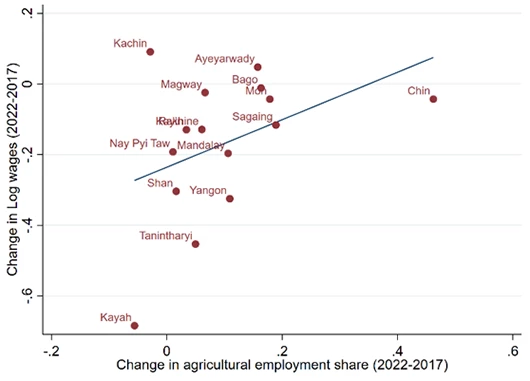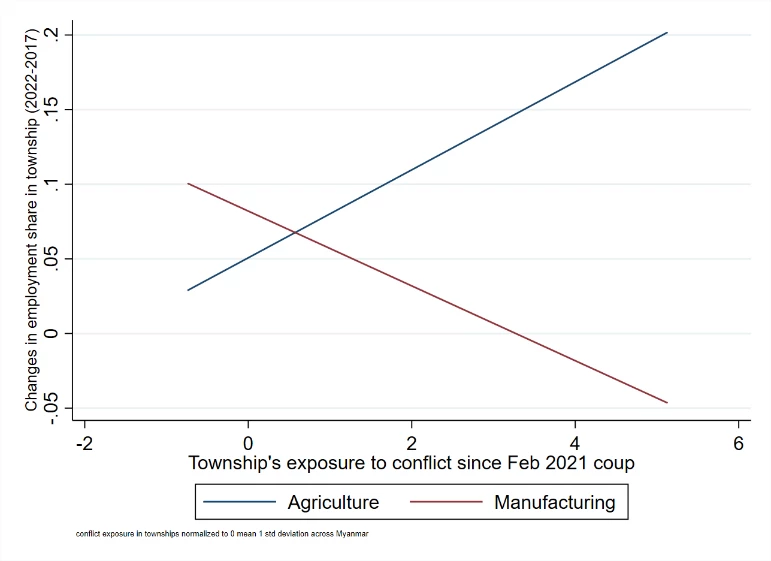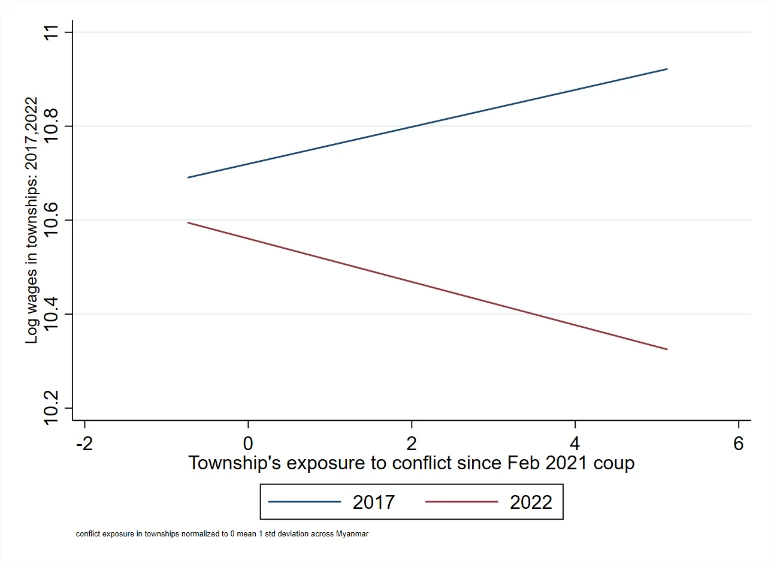 Mandalay, Myanmar — Gong making worksho. | © shutterstock.com
Mandalay, Myanmar — Gong making worksho. | © shutterstock.com
Myanmar's transition to an open market economy in 2011 led to significant gains in GDP per capita and poverty reduction. However, the Covid-19 pandemic and military coup of February 2021 have reversed these gains, with real GDP per capita estimated to be 13% below pre-pandemic levels in 2023, in sharp contrast to other East Asian economies. Myanmar is facing a concerning 2.5 million employment shortfall, with young and undereducated workers struggling to find jobs , a recent World Bank report finds.
The country’s economy is also displaying trends that contrast with historical development patterns in other countries — where at early stages of development, workers in poorer regions shift from low-skilled agriculture to higher-productivity manufacturing jobs — a process known as structural transformation. This shift boosts manufacturing employment and wages in poorer provinces, resulting in wage convergence across regions (Caselli and Coleman, 2001). At later stages of development, countries start experiencing services sector-led growth. Services employment during this time tends to be concentrated in wealthier provinces because these areas provide favorable amenities and location-specific factors that are amenable to service sector firms. This leads to wage divergence, where richer areas experience faster improvement in living standards compared to poorer regions (Chatterjee et al, 2022).
In contrast, wages over the past half-decade have converged in Myanmar, but not because of more manufacturing employment or rising productivity. Household well-being is now more influenced by location-specific factors, but not because of services growth and wage divergence. The objective of this blog to reconcile these contradictory trends.
Structural transformation is reversing — wages are falling everywhere, and even high-skill workers are moving to less productive sectors.
Private sector employment opportunities in Myanmar have become scarce, with a 12-percentage point decrease in the proportion of private sector jobs in the workforce between 2017 and 2022. This has resulted in a 15 percent decline in real wages, with every region reporting lower wages over the past five years. Interestingly, states and regions with higher wages in 2017 have experienced the largest reductions in wage earnings compared to other areas, leading to a pattern of wage convergence across regions (Figure 1).
Figure 1: Convergence in wage earnings between 2017 and 2022

Notes: Sample include wage workers over 15 years of age. The wage data excludes top and bottom 1 percent of all workers due to the presence of outliers. Source: MLCS-2017 and Myanmar Subnational Phone Surveys (MSPS) – 2022. See Sinha Roy (2023) for details.
Unlike other countries, wage convergence in Myanmar has been accompanied by a reversal in structural transformation: between 2017 and 2022, wages have fallen the least in locations with higher agricultural employment. (Figure 2). Moreover, more productive workers, such as college-educated or those with more years of work experience, are being diverted to low-productivity agriculture sector.
Figure 2: Reverse structural transformation

Notes: Sample includes employed individuals over 15 years of age. Average wages and employment are calculated at the state and region level using sampling weights. Source: MLCS -2017 and MSPS – 2022.
Local conditions, predominantly conflict, are likely driving contradictory patterns in labor markets.
If not structural transformation, what factors could lead to subnational wage convergence despite a reversal in structural transformation in Myanmar? The rising influence of location-specific factors could be a likely reason. In 2017, around 12.6% and 14% of the variation in wages could be attributed to worker-specific and township-level characteristics, respectively. However, by 2022, the share of variation in wages across regions that could be explained by worker characteristics has increased by 4.1 percentage points, while that of township-level characteristics has doubled to 28%.
The World Bank report investigates three township-level characteristics that could be influencing living standards: frequent power outages, higher local energy prices, and increased incidents of conflict in areas where workers reside.
Among these, the most substantial impact on household living standards comes from a township's exposure to conflict events. Workers living in townships that were exposed to more conflict incidents since 2021, were more likely to shift from manufacturing to less-productive agriculture (Figure 3). Average wages in these townships were relatively higher in 2017 but higher intensity of conflict in the township since 2021, is associated with greater wage reductions in those areas compared to other locations (Figure 4).
Taken together, the evidence suggests that conflict is likely causing a reversal of structural transformation and driving relatively higher wage reductions in richer than poorer areas . This process has likely yielded a pattern of wage convergence across states and regions. By understanding the role of conflict as a locational level factor, we can reconcile contradictory labor market trends in Myanmar.
Figure 3: Local exposure to conflict and changes in agriculture and manufacturing employment between 2017 and 2022 |
Figure 4: Local exposure to conflict and changes in average wages in 2017 and 2022 |




Join the Conversation